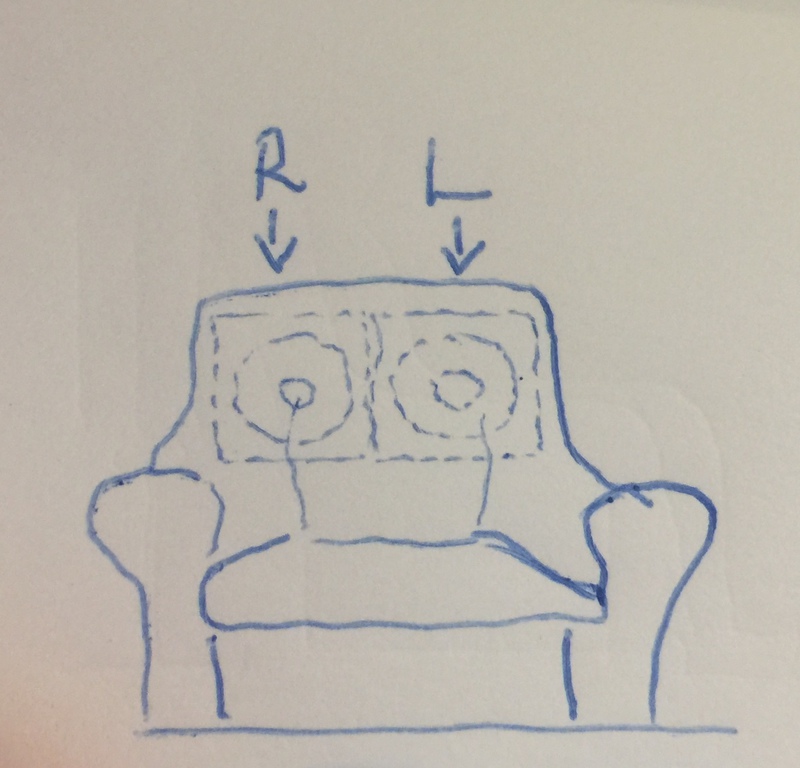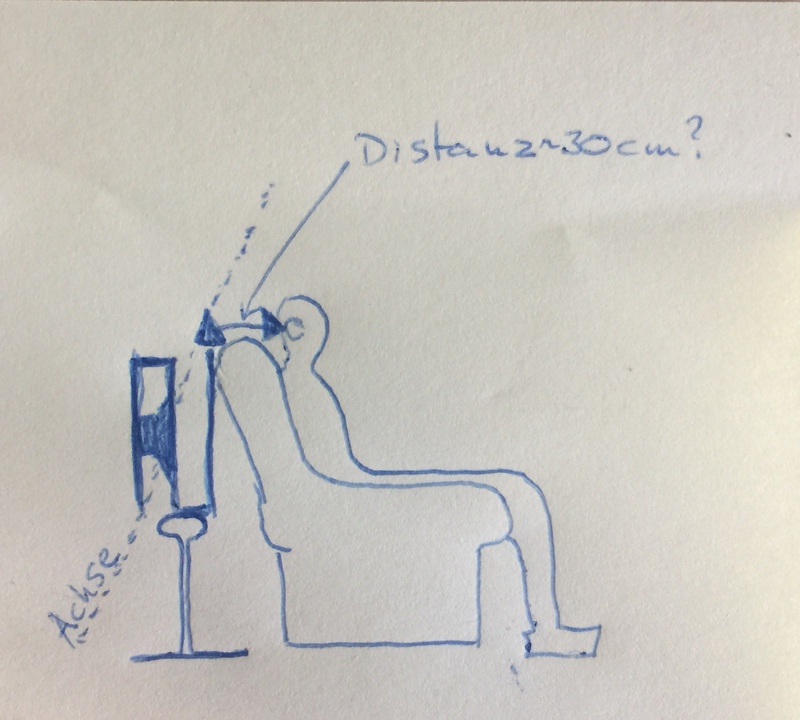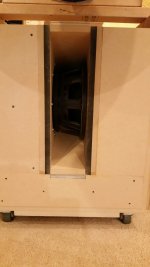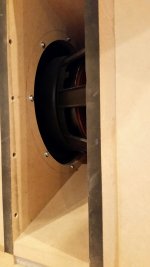Hi everyone, first post here.
Im working on a project, so first thoughts are not exactly acurate, for some time now.
Started 1998, big step to 4 way active horn 2007, and for 2 years now studying basics and buying material (drivers, amps etc).
The goal is, the ultimate final speaker - like many had this plan and failed before
My approach is somehow different, as im collecting all problems, and try to solve all, instead of focusing on 1.
Also, im trying to build a bridge between all the measurables rationals and some "soul" (buying non logical things because u believe sounds / looks sweet though the measures are not justifying )
)
So, in a nutshell, i want to give you a brief forecast bout the plan.
First tell why, thoughts of advantage, and if anyone wants, further xplanations.
1. Basics: In analogue times amplitude response + as little amount of drivers (group delay) was a main focus. Since FIR, all the linear-distortions are invertable, i want to build with focus on room acoustics and non-linear-distortion - which are in my eyes main obstracles.
2. More important than harmonics are multitone or IMD. The more ways the better, out of a principle. Downsides of group delay is handled via FIR.
3. Speakers are usually used in too wide passband, not enough capacity below/above for clean crossover slopes - requires more ways, see point 2.
4. Room acoustics spoil the best concept, its rarely considered thouroughly. The room has to be part of the speaker whereever possible. With special focus on the modal range and Schroeder - band.
5. Active, FIR, efficiency, are of course a must.
My solution is:
DC-90Hz: a nearfield dipole behind the sofa, with 4x15 or 2x21" driver
90-250Hz: two corner horns stacked vertical, each 4x8" drivers, phaseplug + folding mods + mouthmod, per channel
250-700Hz: two lowther PM4a in 1x1x1 meter horn, "half-cut-design" to use floor as a seemless mirror
700-1500Hz: A JBL 2482 in a 220Hz Radial Horn
1500-4000Hz: 2x Fostex FD200L as a pushpull-compound in a 300Hz TAD/Vitaxox-alike Radialhorn
4000-10000Hz: a JBL 2420 driver in JBL 2312 long conical horn
10000-50000Hz: A Fostex T705 tweeter
The mains would stand close to the corners, half meter.
Listening pos. is 3-4 meters triangle, middle of the room.
The complete sealing, front wall, and front part of sidewalls will be covered with special foam, absorbing 100Hz 0.1 / 150Hz 0.5 / 250Hz 1.0 and up.
The narrow beaming of HF + damping will give xcellent response on one hand, but too dry perception on the other. Ill compensate this with:
- a extra channel of wide dispersion slit radiator on the back, 5ms delay (precendence effect) and -10dB below the mains, creating intentional additional room reflections (modifyable)
- also xtra channel of optional (!) small horn & 8" fullrange, to cover on -10dB below mains in a resonant chamber 200-1000Hz a so called "injector" for more 3-dimensional body-borne-noise (verified positive results!)
All channels will be active driven with linear response+phase FIR correction plus soft-slope low order linear-phase crossovers.
I find myself revising details every couple of weeks for last year.
Recently i only make small changes over months, feeling that i head to the end of planning.
I'm asking you which obstracles you see in this concept, what may cause problems, and what i forgot to consider. I hope to find justification to most concerns, but more than that i hope to find an "aaaa yes damn i forgot" thing
cheers
Josh
Im working on a project, so first thoughts are not exactly acurate, for some time now.
Started 1998, big step to 4 way active horn 2007, and for 2 years now studying basics and buying material (drivers, amps etc).
The goal is, the ultimate final speaker - like many had this plan and failed before
My approach is somehow different, as im collecting all problems, and try to solve all, instead of focusing on 1.
Also, im trying to build a bridge between all the measurables rationals and some "soul" (buying non logical things because u believe sounds / looks sweet though the measures are not justifying
So, in a nutshell, i want to give you a brief forecast bout the plan.
First tell why, thoughts of advantage, and if anyone wants, further xplanations.
1. Basics: In analogue times amplitude response + as little amount of drivers (group delay) was a main focus. Since FIR, all the linear-distortions are invertable, i want to build with focus on room acoustics and non-linear-distortion - which are in my eyes main obstracles.
2. More important than harmonics are multitone or IMD. The more ways the better, out of a principle. Downsides of group delay is handled via FIR.
3. Speakers are usually used in too wide passband, not enough capacity below/above for clean crossover slopes - requires more ways, see point 2.
4. Room acoustics spoil the best concept, its rarely considered thouroughly. The room has to be part of the speaker whereever possible. With special focus on the modal range and Schroeder - band.
5. Active, FIR, efficiency, are of course a must.
My solution is:
DC-90Hz: a nearfield dipole behind the sofa, with 4x15 or 2x21" driver
90-250Hz: two corner horns stacked vertical, each 4x8" drivers, phaseplug + folding mods + mouthmod, per channel
250-700Hz: two lowther PM4a in 1x1x1 meter horn, "half-cut-design" to use floor as a seemless mirror
700-1500Hz: A JBL 2482 in a 220Hz Radial Horn
1500-4000Hz: 2x Fostex FD200L as a pushpull-compound in a 300Hz TAD/Vitaxox-alike Radialhorn
4000-10000Hz: a JBL 2420 driver in JBL 2312 long conical horn
10000-50000Hz: A Fostex T705 tweeter
The mains would stand close to the corners, half meter.
Listening pos. is 3-4 meters triangle, middle of the room.
The complete sealing, front wall, and front part of sidewalls will be covered with special foam, absorbing 100Hz 0.1 / 150Hz 0.5 / 250Hz 1.0 and up.
The narrow beaming of HF + damping will give xcellent response on one hand, but too dry perception on the other. Ill compensate this with:
- a extra channel of wide dispersion slit radiator on the back, 5ms delay (precendence effect) and -10dB below the mains, creating intentional additional room reflections (modifyable)
- also xtra channel of optional (!) small horn & 8" fullrange, to cover on -10dB below mains in a resonant chamber 200-1000Hz a so called "injector" for more 3-dimensional body-borne-noise (verified positive results!)
All channels will be active driven with linear response+phase FIR correction plus soft-slope low order linear-phase crossovers.
I find myself revising details every couple of weeks for last year.
Recently i only make small changes over months, feeling that i head to the end of planning.
I'm asking you which obstracles you see in this concept, what may cause problems, and what i forgot to consider. I hope to find justification to most concerns, but more than that i hope to find an "aaaa yes damn i forgot" thing
cheers
Josh
Hi Scott, Hi Kris
"Many XO, low steepness - problematic. "
Yes. Usually.
1. With linear phase FIR the summing on the lis-pos. is still flat, fine & ripplefree.
2. I wasn't precise enough, im using subtraction filter with steep lowpass but soft highpass. Far less critical.
3. This is a pure off-axis problem. Not relevant for the listening position.
Normally it is, because of indirect sound coloration due to lobing. Which should be very very low here, as the room is dampened aggressively on one side, but controlled by the rear-diffuse ones on the other.
4. Majority of coloration is happening on the big off axis scales (60-180°) which is exactly the part of the room killed with foam.
" 1) di-pole bass (aka open baffle) is the single LEAST efficient "
Yes. That's the advantage here. You loose up to 20dB within a few meter.
The reason why you have superband flat response in the nearfield.
Nearfield also boosts the SPL. While all horns are 4 meters away, that one will be 0.3m.
At the end, same result: little voltage, little xcursion, resp. little distortion, while big SPL at the ear.
See simulation and scribble:



simulated at 2.8 volt / less than 1mm xcursion >20Hz
"Many XO, low steepness - problematic. "
Yes. Usually.
1. With linear phase FIR the summing on the lis-pos. is still flat, fine & ripplefree.
2. I wasn't precise enough, im using subtraction filter with steep lowpass but soft highpass. Far less critical.
3. This is a pure off-axis problem. Not relevant for the listening position.
Normally it is, because of indirect sound coloration due to lobing. Which should be very very low here, as the room is dampened aggressively on one side, but controlled by the rear-diffuse ones on the other.
4. Majority of coloration is happening on the big off axis scales (60-180°) which is exactly the part of the room killed with foam.
" 1) di-pole bass (aka open baffle) is the single LEAST efficient "
Yes. That's the advantage here. You loose up to 20dB within a few meter.
The reason why you have superband flat response in the nearfield.
Nearfield also boosts the SPL. While all horns are 4 meters away, that one will be 0.3m.
At the end, same result: little voltage, little xcursion, resp. little distortion, while big SPL at the ear.
See simulation and scribble:



simulated at 2.8 volt / less than 1mm xcursion >20Hz
PMA! has an excellent thread on a horn speaker using dipole woofers. Nelson Pass also published a note on slot loaded dipole woofers. This "stack-them-up" woofer construction might fit your design goals.
My DIY Horn setup
S.L.O.B.S.
Slot Loaded Open Baffle Subwoofer
This dipole cabinet generates a high impact bass wave launch with a focused air pressure energy that travels several feet before diffusing. In a small room, the slot is aimed at the listener in an effort to increase the perceived dynamic impact. This directivity control is a good match to horn or dipole polar pattern. At modest SPL levels, the slot's focused energy wave is linear over a wide frequency range. The slot dimensions are smaller than the crossover wavelength to avoid resonances. JBL measures a directivity index DI = 13 on their dual 15" slot loaded woofers.
My DIY Horn setup
S.L.O.B.S.
Slot Loaded Open Baffle Subwoofer
This dipole cabinet generates a high impact bass wave launch with a focused air pressure energy that travels several feet before diffusing. In a small room, the slot is aimed at the listener in an effort to increase the perceived dynamic impact. This directivity control is a good match to horn or dipole polar pattern. At modest SPL levels, the slot's focused energy wave is linear over a wide frequency range. The slot dimensions are smaller than the crossover wavelength to avoid resonances. JBL measures a directivity index DI = 13 on their dual 15" slot loaded woofers.
This dipole cabinet generates a high impact bass wave launch with a focused air pressure energy that travels several feet before diffusing. In a small room, the slot is aimed at the listener in an effort to increase the perceived dynamic impact. This directivity control is a good match to horn or dipole polar pattern. At modest SPL levels, the slot's focused energy wave is linear over a wide frequency range. The slot dimensions are smaller than the crossover wavelength to avoid resonances. JBL measures a directivity index DI = 13 on their dual 15" slot loaded woofers.
Does not have to be di-pole in order to work. As a matter of fact, I think that an even greater pressure wave is created when there is no wrap around loss.
Attachments
Hi. Do you have experience with this type of OB? I find the pressurisation of a sealed box in my small room uncomfortable (one of the reasons I prefer OB speakers). I presume a SLOB could be a good compromise for the reasons you state?Slot Loaded Open Baffle Subwoofer
This dipole cabinet generates a high impact bass wave launch with a focused air pressure energy that travels several feet before diffusing. In a small room, the slot is aimed at the listener in an effort to increase the perceived dynamic impact.
I like the idea of the sub behind the sofa. Years ago there was a guy (was it you?) over on another forum who did this to have loud bass and not bother the neighbors. Cool idea.
Too many "ways" for me, too. The absolutely best horn system I've ever heard was a 4 way, and could have been stretched to 3-way. All passive crossover, BTW.
Yes, the room is super important. I've heard the same system in many different rooms and it's always amazing how much it changed. At least with the big horns you'll be avoiding many early reflections.
Lofty goals! We look forward to reading about your project.

Too many "ways" for me, too. The absolutely best horn system I've ever heard was a 4 way, and could have been stretched to 3-way. All passive crossover, BTW.
Yes, the room is super important. I've heard the same system in many different rooms and it's always amazing how much it changed. At least with the big horns you'll be avoiding many early reflections.
Lofty goals! We look forward to reading about your project.


Bout the processor, no prob, i use intel i3 standard market product, low cost, even running all 16 channels in 96k and 64bit doublefloat aaaand 131 thousand tabs (insane!) no prob, cpu loughs about that 
Look at minidsp crap, running 7k tabs on all channels together. Id use that for a tweeter....
Guys i tried, it doesnt work with the room modes any other way.
1. Option: you can build a new house for a million and dampen it to death with RAR to get decent levels of modal resonances. No thanks
2. You need 4 channels, designated basement, install front and rearwall DBA with a huge load of speakers and amps, all modes vanish away. No thanks
3. Using any other type of case, its either too far (half meter and hello modes again) or you put those huge subwoofers like 5cm close to you ear....
Kind of intrusive ;-)
4. Only the dipole stays linear up to half a meter from the ear (the closer the better but thats ok to work with). Because only the dipole decreases so strong in spl that theres very little energy for the modes left.
So, sub is settled. No matter what
The only thing im not sure bout yet, if it may cause air noise due to acceleration on the slit, close to my ears. If it does, ill apply same rules like for bassreflex. Put a little cotton in, round the slot edges, and hammer some bumps on the surface to get a golf ball alike structure. Used for venting ports successfully.
Cheers
Josh
Look at minidsp crap, running 7k tabs on all channels together. Id use that for a tweeter....
Guys i tried, it doesnt work with the room modes any other way.
1. Option: you can build a new house for a million and dampen it to death with RAR to get decent levels of modal resonances. No thanks
2. You need 4 channels, designated basement, install front and rearwall DBA with a huge load of speakers and amps, all modes vanish away. No thanks
3. Using any other type of case, its either too far (half meter and hello modes again) or you put those huge subwoofers like 5cm close to you ear....
Kind of intrusive ;-)
4. Only the dipole stays linear up to half a meter from the ear (the closer the better but thats ok to work with). Because only the dipole decreases so strong in spl that theres very little energy for the modes left.
So, sub is settled. No matter what
The only thing im not sure bout yet, if it may cause air noise due to acceleration on the slit, close to my ears. If it does, ill apply same rules like for bassreflex. Put a little cotton in, round the slot edges, and hammer some bumps on the surface to get a golf ball alike structure. Used for venting ports successfully.
Cheers
Josh
Last edited:
I have problems with room modes, is it because they are U frames? Is the SLOB better in that regard?Because only the dipole decreases so strong in spl that theres very little energy for the modes left.
7-way FIR? show me the processor
Cheap:
MacBook - Apple (DE)
Cheaper:
Introseite - AudioVero
For free
Lernvall Audio
- Status
- This old topic is closed. If you want to reopen this topic, contact a moderator using the "Report Post" button.
- Home
- Loudspeakers
- Multi-Way
- Ultimate Horn Speaker - First thoughts


